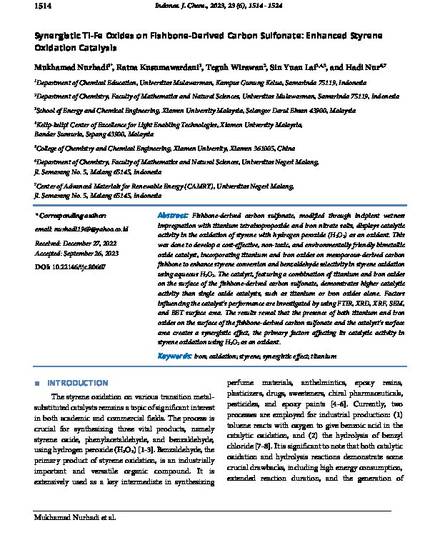
Article
Synergistic Ti-Fe Oxides on Fishbone-Derived Carbon Sulfonate: Enhanced Styrene Oxidation Catalysis
Indonesian Journal of Chemistry
(2023)
Abstract
Fishbone-derived carbon sulfonate, modified through incipient wetness impregnation with titanium tetraisopropoxide and iron nitrate salts, displays catalytic activity in the oxidation of styrene with hydrogen peroxide (H2O2) as an oxidant. This was done to develop a cost-effective, non-toxic, and environmentally friendly bimetallic oxide catalyst, incorporating titanium and iron oxides on mesoporous-derived carbon fishbone to enhance styrene conversion and benzaldehyde selectivity in styrene oxidation using aqueous H2O2. The catalyst, featuring a combination of titanium and iron oxides on the surface of the fishbone-derived carbon sulfonate, demonstrates higher catalytic activity than single oxide catalysts, such as titanium or iron oxides alone. Factors influencing the catalyst's performance are investigated by using FTIR, XRD, XRF, SEM, and BET surface area. The results reveal that the presence of both titanium and iron oxides on the surface of the fishbone-derived carbon sulfonate and the catalyst's surface area creates a synergistic effect, the primary factors affecting its catalytic activity in styrene oxidation using H2O2 as an oxidant.
Keywords
- iron; oxidation,
- styrene,
- synergistic effect,
- titanium
Disciplines
Publication Date
2023
DOI
10.22146/ijc.80667
Citation Information
Mukhamad Nurhadi, Ratna Kusumawardani, Teguh Wirawan, Sin Yuan Lai, et al.. "Synergistic Ti-Fe Oxides on Fishbone-Derived Carbon Sulfonate: Enhanced Styrene Oxidation Catalysis" Indonesian Journal of Chemistry Vol. 23 Iss. 6 (2023) p. 1514 - 1524 Available at: http://works.bepress.com/hadi_nur/256/
